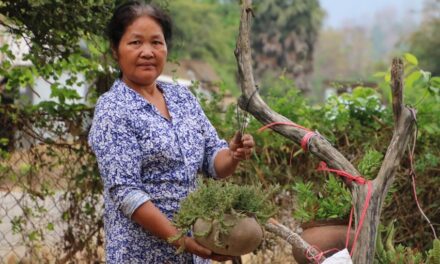By TambuyogDevelopmentCenter, September 2003
IN PRINCIPLE, fisheries production and trade should enhance resource sustainability and food security for fisher-producers, in accordance with the mandate of the 1987 Philippine Constitution and the 1998 Fisheries Code. The mere liberalization of fisheries trade does not guarantee either resource sustainability or food security, particularly food security based on self-sufficiency or self-reliance. On the contrary, it only serves to worsen resource depletion and food insecurity, especially that of local communities that have traditionally used and depended on the now-heavily traded fishery and coastal resources.
, fisheries production and trade should enhance resource sustainability and food security for fisher-producers, in accordance with the mandate of the 1987 Philippine Constitution and the 1998 Fisheries Code. The mere liberalization of fisheries trade does not guarantee either resource sustainability or food security, particularly food security based on self-sufficiency or self-reliance. On the contrary, it only serves to worsen resource depletion and food insecurity, especially that of local communities that have traditionally used and depended on the now-heavily traded fishery and coastal resources.
The Trade Context in Philippine Fisheries
The lowering of tariffs in fisheries has been in effect since 1993 as a part of the Philippine commitment to the Asean Free Trade Association (AFTA), particularly under the Common Effective Preferential Tariff (CEPT), a council under AFTA. A yearly schedule of tariff reduction was set until the target tariff of 0-5 percent was reached by 2002. This schedule of commitment to CEPT was subsequently submitted by thePhilippinesto the World Trade Organization (WTO), in effect binding the country to comply with this commitment (Tambuyog, n.d.).
It should be noted, however, that the 1998 Fisheries Code provides contrary trade restrictions to fish importation. It allows the importation only of fishery products intended for processing and canning, although the Department of Agriculture Secretary, with concurrence from the Fisheries and Aquatic Resource Management Council (FARMC), can issue a certificate of necessity to import that will allow importation for the local wet market (SIKAT, 2001).
Local fisheries trade does not fall under the jurisdiction of the Agreement on Agriculture, but it is still covered by several other agreements of the WTO, namely: 1) general rules of the General Agreement on Tariffs and Trade (GATT), 2) Agreement on Sanitary and Phytosanitary Measures, 3) Agreement on Import Licensing Procedures, 4) Agreement on Technical Barriers to Trade, 5) Agreement on Safeguards, and 6) Agreement on Subsidies and Countervailing Measures (SIKAT, 2001).
Recently, negotiations for a separate agreement on non-agricultural products (in which fishery products are included) have gained ground in the WTO. The Negotiating Group on Market Access (NGMA) came out with a draft paper in August 2003 that aimed to define the “elements of modalities” for negotiations on non-agricultural products. With regard to tariff (one of the “modalities”), the draft calls for its elimination through three phases of equal length starting from the bound rates of 2001. The draft also proposes that non-tariff barriers be identified, examined and addressed by the NGMA or other bodies within the WTO, taking into account “the principle of special and differential treatment for developing and least-developed” countries (World Trade Organization, 2003).
As in other key areas of negotiations in the WTO, the position of the Philippine government on the NGMA draft is a well-kept secret and not well-consulted, even though the Filipino people, especially the three-million small fisherfolk, will be affected by the effects of any agreement it commits the fisheries sector with regard to trade liberalization. But going by its previous commitment in the CEPT, tariff elimination in fisheries is a foregone conclusion.
Trade Liberalization and Resource Over-exploitation
The application of low tariffs, especially zero tariffs in accordance with the commitments to CEPT and WTO, is not compatible with resource sustainability and food security for the country.
An open access situation of both coastal and offshore resources prevails in the country and in the international waters where the stocks of many pelagic (i.e., migratory) fishes such as tuna and mackerel are located and shared among different fishing countries. The elimination of tariffs, along with other non-tariff barriers, is a prescription for heightened resource exploitation that will result in resource depletion in the long run. In the absence of resource management measures, trade liberalization is an incentive for fish exporting countries to over-exploit pelagic species. But importing countries will not benefit from lesser fishing activities of pelagic species like tuna and mackerel. Hanneson’s argument that fish stocks will recover in importing countries (mentioned in Worldwide Fund for Nature, 2002) ) may not hold true for shared pelagic stocks found in well-defined portions of the world’s seas that cut across several countries.
At present, thePhilippinesis both a fish exporting and importing country; a single species that it both exports and imports (although the latter at a limited amount) is tuna. Resource depletion will only cause economic dislocation and food insecurity in the country, especially for the fisherfolk and other people in the local communities that used to benefit directly or indirectly from the depleted resources. Resource depletion is true not only for capture fisheries but also for aquaculture. Increasing exports of shrimp and other aquaculture products will encourage greater resource exploitation in an open access situation that in the end will only result in the depletion of coastal resources.
Differential Negative Effects
Tuna
In tuna fisheries, the effects of trade liberalization are a bit complicated since there are at least three sub-sectors with their different interests. The canning and processing sub-sectors also operate most of the commercial tuna fishing in the country. Thus, it may be cheaper to rely on tuna imports in the short run, rather than continue engaging in costlier fishing operations.
The tuna hand-line sub-sector, which consists of the most number of fishers or producers (more than 20,000 fishers), will be adversely affected by the lowering of tuna prices brought about by the influx of cheaper tuna imports. This is so because the hand-line sub-sectors also sell a large part of their products in the domestic market. It is unclear if the lowering of tariffs will result in more tuna exports toJapan, the traditional export market of hand-line produced tuna.
At present, importation of tuna is allowed in limited amount to “institutional” buyers such as tuna canneries and processing plants under Fisheries Administrative Order 195, series of 1999. But somehow, the tuna imports—mostly from Taiwanese fishing vessels—find their way into the local wet markets inMindanaoand even the Japanese market. Already, we can foresee the possible consequences of zero tariffs on fish imports from this on going smuggling of Taiwanese tuna that uses FAO 195 as a cover. Tuna smuggling has already caused the prices of tuna in the local wet market and even the Japanese market to fall to nearly half of the previous levels. Taiwanese tuna is cheaper partly because Taiwanese fishers are subsidized, that is, they can buy fuel at a much lower cost inIndonesiathan Filipino tuna hand-liners can in the Philipines due to the Taiwanese-Indonesia Access Agreement. Also, being illegal, smuggling is “tariff-free”.
This steep fall in tuna prices is already causing economic dislocation among Filipino tuna hand-liners. In the long run, the entire tuna industry will suffer from the consequences of unsustainable resource exploitation. Depletion of tuna stocks in both local and international waters will mean costlier production and higher prices. An estimated 60,000 workers dependent on the local tuna industry will be displaced. A total of 300,000 people will be affected if the family members of tuna workers are included.
Small pelagic species
On the other hand, domestic trade in small pelagics such as mackerel and roundscad (locally known as galunggong) will be negatively affected by the expected influx of heavily subsidized foreign small pelagics from such countries asTaiwanandChina. While this may discourage local resource exploitation, it will have an immediate negative impact on the small commercial and municipal subsectors whose economic survival is considerably dependent on the capture of small pelagics. In the long run, even resource sustainability is not ensured since the habitat of roving, small pelagics is not confined within the country’s territorial waters but stretches along a certain portion of the international waters.
At present, limited importation of mackerel by institutional buyers such as sardine processors is allowed. Like tuna imports, mackerel imports have found their way from the Navotas Fish Port Complex to several wet markets in Metro Manila andLuzon. While too limited yet to cause a major impact, the presence of imported mackerel in these wet markets has already caused fish prices to fall (SIKAT, 2001).
Shrimp
Low tariffs will be an incentive for shrimp farm owners to intensify production since this will mean greater income (even if only in the short run). But intensive shrimp farming will only multiply and worsen the harm that it has already caused the environment and the local communities since the late 1980’s.
It is well-established by now that intensive shrimp farming (and aquaculture in general) brings negligible economic benefit while overwhelming the environment and local communities with the ill effects of its market “externalities”. Besides the tax revenues that they pay to the government (which are small anyway due to tax credits), shrimp farm owners pocket the bulk of profits from shrimp exports. The actual amount of foreign exchange earning from shrimp exports is not clear. Virtually no economic benefit redounds to the local communities since only a few workers are employed in shrimp farming.
In contrast, the market “externalities” are numerous and staggering. one of these is the loss of mangroves that provide habitat for other coastal species and is thus important to the productivity of coastal ecosystems, besides protecting local communities from storms. Other effects include the sinking of land and flooding, salination of drinking water, discharge of water-polluting toxic antibiotics and chemicals, and release of fishpond sludge that cause water siltation and soil salination (Tambuyog, 2000).
Moreover, coastal lands that used to be common property resources are virtually “privatized” under existing very liberal fishpond lease agreements granting lessees and their inheritors up to 50 years of fishpond operation. This situation has already brought economic dislocation to subsistence fishers who use to gather shells and crustaceans in what used to be mangrove areas (Tambuyog, 2000). Above all, domestic food supply has declined due to lower productivity of coastal areas and because of the steep rise in shrimp prices resulting from its exportation to the markets of developed countries (Tambuyog, 2003).
Severe as these “externalities” already are, lower tariffs for shrimp in the world market will only worsen their impact in the environment and local communities.
Overall Negative Impact on Food Security
The food security of local producing communities will be threatened by the negative consequences of low tariff such as long-term resource depletion and market “externalities”. The economic dislocation of tuna hand-line fishers and their dependents (an estimated total of 120,000 people) will be immediately felt due to the fall of tuna prices in the domestic market. Similarly, small fishers dependent on the production and trade of small pelagics will more or less suffer economically.
In the shrimp industry, intensification of fishpond operations will exacerbate food insecurity in local coastal communities who depend on the remaining mangrove areas and other coastal resources for their subsistence, as it continues to wreak havoc on these mangrove areas and coastal resources.
Alternative Production and Trade System
It is worth reiterating that, in principle, trade should not be a means for the economic disempowerment of local communities of producers. Rather, it should be a means to enhance resource sustainability and the food security of these local communities based on food self-sufficiency or self-reliance. Trade liberalization by itself does not ensure either resource sustainability or food security.
Sustainable Production and Trade
Production and trade should be based on the maximum sustainable yield and carrying capacity values of the resource base. Production should be undertaken hand in hand with effective resource management. Without resource management, increasing production under a liberalized trade regime of low or zero tariffs is a sure recipe for disaster.
For shrimp (and aquaculture production in general), it will mean not only internalizing all market externalities or shifting to sustainable production methods and systems, but also ensuring that the profits from trade redounds to the local communities that have traditionally used and benefited from the resource base now being used for aquaculture. With its severe “externalities”, intensive aquaculture should be restricted and ultimately phased-out.
Bottom-up Decision-Making on Trade Rules
Besides ensuring that resource management goes hand in hand with production and trade, there should be alternative, bottom-up decision-making processes and mechanisms on trade that includes the representatives of local institutions of producers and other community stakeholders as vital components in the entire course of developing sustainable and community-friendly trade rules on the international level. Such local institutions should necessarily include producers’ organizations and local resource management institutions.
The processes of decision-making on trade, however, should take place within an environment that ensures access to information and information flow so that decisions arrived at will be informed and democratic. Informed decision on trade rules by local institutions and other stakeholders such as the government should be grounded on the principles of resource sustainability and food security.
As it is, the present system of arriving at trade negotiating positions by the Philippine government, together with the existing representation in WTO negotiating bodies, is undemocratic, non-transparent and dominated by government representatives beholden to neo-liberal international interests. Without doubt, this system should be changed.
Application of Quotas and Subsidies
For tuna and small pelagics, sustainable trade will mean trade restrictions in the form of import quotas based on the domestic need. There should also be trade (both domestic export) quotas consistent with maximum sustainable yield and carrying capacity values of fishery stocks and resource base.
At the same time, the government should provide subsidies in the form of resource management, research and development on appropriate tuna production and processing technology, and even production capital assistance to less financially-able but potentially more productive and more sustainable sub-sectors like the tuna hand-liners.
The alternative calls for the rejection of low tariff impositions on fishery products. It should be noted that five years after the GATT Uruguay Round of 1986, majority of member-countries increased their tariff rates, perhaps in anticipation of later hard bargaining and negotiations to lower tariff rates. In contrast, our country early on submitted much lower tariff commitments, thus starting the tariff negotiations from a weaker position relative to other countries. Similarly, prohibited and actionable subsidies in fisheries and other industries have been maintained and not lowered by developed countries up to the present. Why has the Philippine government acquiesced too readily to the GATT-WTO demands?
Our country needs to maintain trade restrictions in fisheries. Aside from this, subsidies that enhance resource sustainability, productivity and efficiency must also be applied. Both trade restrictions and subsidies can be negotiated within the ambit of the WTO using such modalities as special and differential treatment of developing countries, or outside the WTO, by making use of existing regional and bilateral alliances and working with like-minded countries to push for an alternative to fisheries trade liberalization.
References:
SIKAT.A Glimpse of Fisheries Trade: Effects of Imported and Smuggled Fish on the Industry(unpublished paper by Alan Vera & Malou Vera), 2001.
Worldwide Fund for Nature. A Framework on the Sustainability Assessment of the Tariff Reform Program on thePhilippine Fishery Sector (unpublished paper), 2002.
TambuyogDevelopmentCenterand the Center for Empowerment and Resource Development.CASA CaseStudy of Shrimp Farming (unpublished paper), 2000.
TambuyogDevelopmentCenter.Frequently Asked Questions on Fish Trade (unpublished paper), n.d.
TambuyogDevelopmentCenter.Right to Food Fish (unpublished paper), 2003.
World Trade Organization.Draft Elements of Modalities for Negotiations on Non-Agricultural Products (unpublished paper), 2003.








